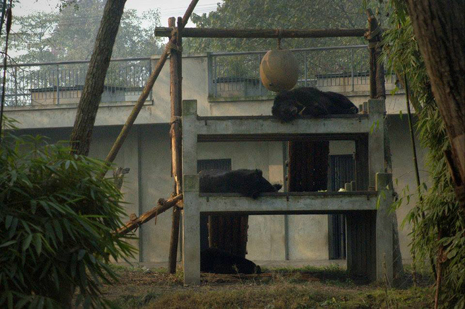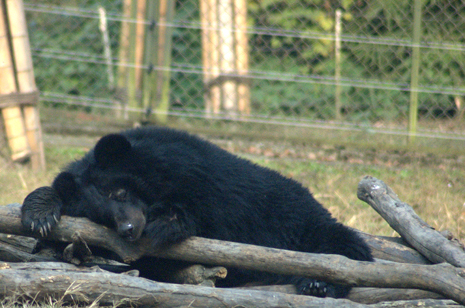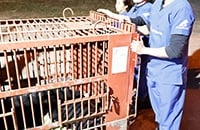A year in the sanctuary life of a moon bear
24 January 2014
Sofie Meilvang, Bear Manager at Animals Asia's sanctuary in Chengdu, China shares her thoughts and experience on how the seasons effect the moon bears and the care they are given.
In January, which is cold and grey in Chengdu, many bears start getting sleepier. Not all of our bears go on ‘”winter lock down” (WLD), a term that we use for bears shut inside the dens during the winter time. It varies from individual to individual and also from year to year. Signs of being ready for WLD also vary.
Some bears will start getting up later in the morning, their appetite will decrease and they will miss calls to go back inside as they will be snoozing in the enclosure. Some will start building nests and can sometimes seem a bit vacant or confused. It can be hard to move them between dens or weigh them, as they can suddenly forget why they are moving around or are in a weigh cage. Often they will just sit down and take a long time to move.
Other bears will increase “stereotyping” or pace in the enclosure when they are ready for WLD.

Other bears will not show any sign of winter dormancy, but will, from one day to the next, start sleeping in the enclosure. Therefore, the whole team has to keep a very close eye on potential WLD bears. If a bear goes into hibernation in the enclosure it means that we can’t go in there to clean or set up enrichment for all the other bears.
When a bear is placed on WLD they will be shut inside the dens and given lots of bedding material such as straw, hessian sacks or dried leaves so he or she can build a nice, comfortable nest in the basket. The bears don’t get any enrichment during their WLD time, but will always be offered at least one meal a day. Some will come down to eat twice while others will eat minimally for months.
Some bears pair up during the winter and become inseparable. They will share the same basket and keep each other warm. Often, when they are done with the hibernation they will split up and only pair up when it’s getting to be “that time of year” again.
When spring approaches, the bears will slowly get more active. Some will have been on WLD for up to six months, while others only sleep inside for a few weeks. Other bears go through the whole winter without sleeping any more than normal.
When bears wake up from hibernation in the wild, there will not be a lot of food to eat yet. Their appetites reflect this. When the bears at our sanctuary wake up and are let out from WLD, their appetites will still be low and will slowly increase over the following months.
When summer hits Chengdu the bears will start becoming active again. They will spend their days climbing trees, eating the new leaves and cooling down, swimming in the pool. At this time of year the bears go on to what we call “double recall”. Twice a day the bears are recalled back to the dens so the team can set up enrichment for them. During the slower winter months, we only recall them once a day. The “double recall” has been proven to decrease the stereotyping of many of the bears, as it keeps them occupied longer.
As the season shifts into the autumn the bears’ appetites peak. The bears need lots of food and we often increase their amounts from week to week. They especially crave dog food that provides them with protein and fat that helps them build up reserves for the coming winter. We have to keep a very close eye on the bears at this time of year.
If they are not getting enough food, aggression may occur between group members. It’s a fine balance to make sure they get enough food but also are not getting too fat, which could contribute to mobility problems for the bears.
In the autumn we start feeding the bears more nuts, such as peanuts and chestnuts, to reflect what they would eat in the wild at this time of year. The nuts are given as part of the enrichment program and will be spread and hidden all over in the enclosure to encourage the bears’ foraging behavior.
In December bears’ appetites will gradually start to decrease again and the first bears will be ready to go on to WLD. Often we will see a big drop in appetite just around the beginning of the year and then we are back to where we started.

BACK




 5 reasons the dog meat trade must end
5 reasons the dog meat trade must end
 New year, new home for Christmas the Bear!
New year, new home for Christmas the Bear!
 Veterinary welfare training – pain management
Veterinary welfare training – pain management